California is projected to see more deaths than any other state due to wildfire smoke by midcentury — part of a nationwide surge that could claim tens of thousands of lives annually without protective measures, a new study warns.
Why it matters: The grim findings are among the strongest evidence on record of the harmful effects of climate change, the study’s authors say.
- Under the worst climate scenarios, wildfire smoke could cause more than 70,000 excess deaths per year by 2050, per the study.
“The impacts are much larger than anything else that has been measured,” Marshall Burke, an environmental economist at Stanford University who contributed to the study, told the New York Times.
What they did: The research team used 20 years’ worth of death records, satellite and ground data and climate models to study the relationship between exposure to wildfire smoke and mortality.
Zoom in: California alone could see up to 4,551 excess deaths per year by midcentury, according to the research.
- This year’s wildfire season in California is proving more severe than last — and wildfires have evolved into a year-round threat.
- The San Francisco Bay Area is no stranger to smoke inundation. During the 2020 August Complex fires, San Francisco experienced some of the worst air quality in the world when skies turned orange and ash blanketed the city.
What they’re saying: “Our research suggests that the health impacts of climate-driven wildfire smoke could be among the most important and costly consequences of a warming climate in the U.S.,” the study authors wrote.
Threat level: Fine particulate matter (PM2.5) in wildfire smoke poses significant health risks considered more hazardous than other types of air pollution.
- PM2.5 can increase the risk of lung irritation, asthma, respiratory infections, heart attacks, strokes and more, and can be especially harmful to vulnerable populations like children, seniors and immunocompromised individuals.
Yes, but: There are ways to mitigate the health impacts.
- Better forest management could help reduce the severity of wildfires.
- Air filters and protective masks can help shield people from wildfire smoke.
- Cutting climate pollution can lower the risk of large, deadly fires.
The bottom line: “These are projections. They are not what’s going to happen, necessarily,” Burke told the New York Times.
- “But what happens is a choice, and so these don’t have to be an inevitability.”
